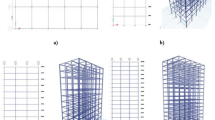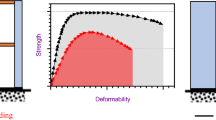Abstract
The seismic behavior of a school gymnasium, whose steel grid roof was heavily damaged during the Mw6.6 Lushan earthquake in 2013, is simulated through nonlinear dynamic analysis. The simulated damage is compared with field observations to validate the numerical model, based on which a parametric study was performed to provide insight into the failure process and damage patterns of steel grids. The results suggest that the grid damage is strongly related to roof-substructure interactions. These include not only the substructure’s amplification of the vibration, but the uncoordinated displacement of the substructure’s columns which support the grid also play an equally important role. In particular, the latter effect may significantly alter the internal force distribution in the steel grid and lead to unexpected buckling of members that are proportioned as tension-only members. While such interactions are generally not accounted for in the design practice for grid structures in China, similar seismic damage may be expected for other existing grid roofs in future earthquakes. As is also demonstrated in this study, seismic isolation of the roof is a promising solution to protect grid roof structures by mitigating the detrimental effects of roof-substructure interactions.
Similar content being viewed by others
References
ABAQUS Inc (2010), ABAQUS, Version 6.10. ABAQUS Inc.
AIJ (1995), “Preliminary Reconnaissance Report of the 1995 Hyogoken-Nanbu Earthquake (English Edition),” AIJ: 61–63.
AIJ (2011), “Reports on Seismic Performance of School Buildings,” AIJ: 350–402. (in Japanese)
Bhagat S and Wijeyewickrema AC (2017), “Seismic Response Evaluation of Base-Isolated Reinforced Concrete Buildings under Bidirectional Excitation,” Earthquake Engineering and Engineering Vibration, 16(2): 365–382.
China Earthquake Administration (2013), Earthquake Intensity Map of M7.0 ‘4.20’ Lushan Earthquake in Sichuan, Released on April 25, 2013. (in Chinese)
Dai Junwu, Qu Zhe, Zhang Chenxiao and Wen Xuran (2013), “Preliminary Investigation of Seismic Damage to Two Steel Space Structures during the 2013 Lushan Earthquake,” Earthquake Engineering and Engineering Vibration, 12(3): 497–400.
Fan Zhongxuan (1992), “Analysis of the Seismic Damage to the Grid Roof of the Wu Qia Theater under the Earthquake Action of Intensity 9,” Earthquake Resistant Engineering and Retrofitting, 2: 41–44. (in Chinese)
Fan F, Sun MH and Zhi XD (2016), “Simplified Design Method and Seismic Performance of Space Trusses with Consideration of the Influence of the Stiffness of Their Lower Supporting Columns,” Earthquake Engineering and Engineering Vibration, 15(2): 401–409. https://doi.org/10.1007/s11803-016-0327-z.
Hanaor A (2011), “Design and Behavior of Reticulated Spatial Structural Systems,” International Journal of Space Structures, 26(3): 193–203. https://doi.org/www.cea.gov.cn/publish/dizhenj/468/553/100342/100345/20130424151225623554842/index.html
Lan Pei’en and Qian Ruojun (1991), “Analysis of the Seismic Damage to the Grid Roof of the Wu Qia Theater Located in Xin Jiang Province,” Building Structure, 5: 43–47. (in Chinese)
Malla RB and Serrette RL (1996), “Double-Layer Grids: Review of Dynamic Analysis Methods and Special Topic,” Journal of Structural Engineering, 122(8): 882–892.
McGuire RK (1978), “Seismic Ground Motion Parameter Relations,” Journal of the Geotechnical Engineering Division, ASCE, 104(4): 481–490.
McKenna FT (1997), “Object Oriented Finite Element Programing: Frameworks for Analysis, Algorithms and Parallel Computing,” PhD Thesis, University of California, Berkeley, California, U.S.
JGJ 7-91 (1992), Regulation of Design and Construction of Grid Structures, Beijing: China Architecture & Building Press. (in Chinese)
GB50011 (2001), Code for Seismic Design of Buildings, Beijing: China Architecture & Building Press. (in Chinese)
GB50011 (2008), Code for Seismic Design of Buildings, Beijing: China Architecture & Building Press. (in Chinese)
GB50010 (2002), Code for Design of Concrete Structures, Beijing: China Architecture & Building Press. (in Chinese)
Moghaddam HA (2004), “Seismic Behavior of Space Structures,” Proceeding of the 13th World Conference on Earthquake Engineering, Paper No. 523.
Qu Zhe and Ye Lieping (2010), “Strength Deterioration Model Based on Effective Hysteretic Energy Dissipation for RC Members under Cyclic Loading,” Proc. 7th international Conference on Urban Earthquake Engineering (7CUEE) & 5th International Conference on Earthquake Engineering (5ICEE), Tokyo, Japan, March 3–5: 851–856.
Su Liang, Dong Shilin and Kato S (2007), “Seismic Design for Steel Reused Arch to Multi-Support Excitation,” Journal of Constructional Steel Research, 63: 725–734.
Sun MH, Fan F, Sun BT and Zhi XD (2016), “Study on the Effect of Ground Motion Direction on the Response of Engineering Structure,” Earthquake Engineering and Engineering Vibration, 15(4): 649–656. https://doi.org/10.1007/s11803-016-0355-8.
Trifunac MD and Brady AG (1975), “Study on the Duration of Strong Earthquake Ground Motion,” Bulletin of the Seismological Society of America, 65(3): 581–626.
Yu Zhiwei, Zhi Xudong, Fan Feng and Chen lu (2011), “Effect of Substructures upon Failure Behavior of Steel Reticulated Domes Subjected to the Severe Earthquake,” Thin-Walled Structures, 49(9): 1160–1170.
Yuan Si (2008), Structural Mechanics Solver, version 2.5, Higher Education Press, Beijing.
Zhang Yigang and Kong Xianghe (1998), The Aseismic Characteristic of Full Structure System Including Space Trusses under Horizontal Earthquake, Industrial Construction, 7: 1–5. (in Chinese)
Zhou FL and Tan P (2018), “Recent Progress and Application on Seismic Isolation Energy Dissipation and Control for Structures in China,” Earthquake Engineering and Engineering Vibration, 17(1): 19–27. https://doi.org/10.1007/s11803-018-0422-4.
Acknowledgement
The research is sponsored by a project of the National Science & Technology Support Program during the Twelfth Five-year Plan Period of China (2015BAK17B02, 2015BAK17B03), the Scientific Research Fund of Institute of Engineering Mechanics, CEA (2014A01), the Program for Innovative Research Team in China Earthquake Administration, the International Science & Technology Cooperation Program of China (2014DFA70950) and a general program of National Natural Science Foundation of China (51578515). The authors also appreciate the assistance of the China Strong Motion Networks Center in providing the strong motion records in the Lushan earthquake and the parameters of the strong motion stations.
Author information
Authors and Affiliations
Corresponding author
Additional information
Supported by: National Science & Technology Support Program during the Twelfth Five-year Plan Period of China under Grant No. 2015BAK17B02, 2015BAK17B03, the Scientific Research Fund of Institute of Engineering Mechanics, CEA under Grant No. 2014A01, the Program for Innovative Research Team in China Earthquake Administration, the International Science & Technology Cooperation Program of China under Grant No. 2014DFA70950 and a general program of National Natural Science Foundation of China under Grant No. 51578515
Rights and permissions
About this article
Cite this article
Li, J., Qu, Z. & Wang, T. Lessons from the seismic behavior of a steel grid roof structure heavily damaged in Lushan earthquake. Earthq. Eng. Eng. Vib. 18, 95–111 (2019). https://doi.org/10.1007/s11803-019-0492-y
Received:
Accepted:
Published:
Issue Date:
DOI: https://doi.org/10.1007/s11803-019-0492-y




